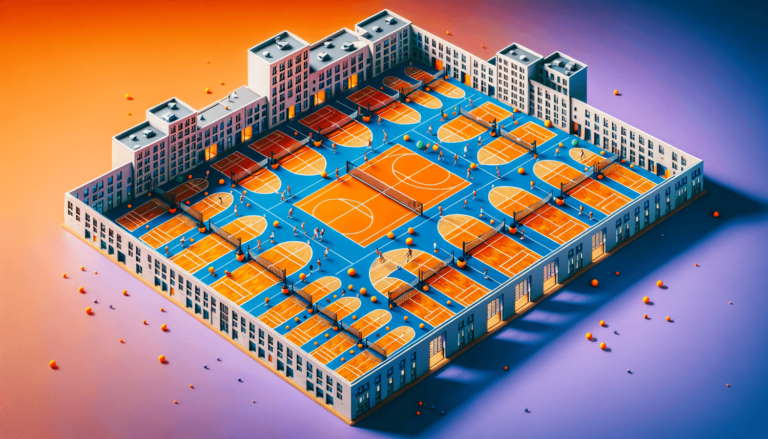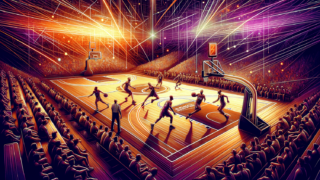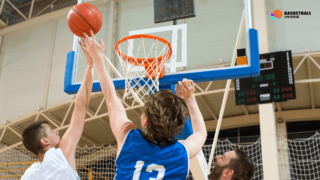
How Many Pickleball Courts Fit on a Basketball Court?
Written by: Basketball Universe
Last updated:

Imagine combining the energetic spirit of basketball with the growing craze of pickleball, and you’ll find yourself with an interesting question: just how many pickleball courts can we squeeze onto a basketball court? In this fun and professional exploration, we’ll take a deep dive into the dimensions of both sports, comparing the playgrounds and analyzing the endless possibilities. Prepare to have your pickleball and basketball knowledge taken to new heights as we unveil the answer to this fascinating puzzle.
How Many Pickleball Courts Fit on a Basketball Court?
A standard basketball court measures 94 feet by 50 feet, while a pickleball court measures 44 feet by 20 feet. Considering the dimensions, approximately four pickleball courts can fit comfortably on a basketball court, with the potential for additional space for spectators or equipment storage.
Understanding the Basics: The Dimensions of Basketball and Pickleball Courts
Before diving into the world of fitting pickleball courts onto a basketball court, it’s essential to understand the dimensions and measurements of each. For starters, a standard, full-length basketball court measures 94 feet by 50 feet (28.65 meters by 15.24 meters). Meanwhile, a regulation-sized pickleball court is measured at 44 feet by 20 feet (13.41 meters by 6.1 meters).
Basketball Court Dimensions
Basketball courts come in different dimensions, depending on the league or organization; however, we will focus on the NBA size. A regulation basketball court (NBA) must have specific markings and measurements, including a free-throw line situated 15 feet from the backboard, and a three-point line ranging from 22 feet to 23 feet and 9 inches away from the basket. The key or paint area, where most of the action happens, measures 16 feet wide and stretches from the baseline to the free-throw line.
Pickleball Court Dimensions
Though smaller in size compared to a basketball court, a standard pickleball court is no less engaging. With dimensions of 44 feet by 20 feet, a pickleball court is divided into two equal 22-foot by 20-foot sides by a net set at a height of 36 inches. Each side features a 7-foot Non-Volley Zone or “kitchen,” prohibiting players from taking volleys within this area. The court is marked with a baseline, service court lines, and a centerline, providing clear sections for organized gameplay.
Crunching the Numbers: Calculating Court Occupancy
With the basic dimensions set for both basketball and pickleball courts, we can start making our calculations. Since a basketball court’s surface area equals 4,700 square feet (94 x 50), while a pickleball court stands at 880 square feet (44 x 20), we can use these numbers to determine how many pickleball courts would fit onto a basketball court.
Area Efficiency and Arrangement
Dividing the basketball court’s surface area (4,700 sq. ft.) by a pickleball court’s surface area (880 sq. ft.), we get a quotient of 5.34. But since we cannot have 0.34 of a pickleball court, we must adjust the number of courts and use the available space effectively.
Upon reevaluation, the ideal scenario involves fitting four pickleball courts on a basketball court. By placing these courts side-by-side, each will occupy a 40-foot width, giving you an overlap of 10 feet in width (50-40) to allocate for buffer zones such as spectator seating or equipment storage. Lengthwise, two pickleball courts will measure 88 feet, leaving 6 feet to cater for additional spacing between courts.
Think of this arrangement as a convenient and accommodating setup for pickleball enthusiasts, enough for an impromptu tournament amongst friends or some serious practice sessions.
The World of Multi-Sport Courts
Within recreational facilities and sports clubs, many venues are taking a modern approach to maximizing space utilization with multi-sport courts. These courts exhibit excellent adaptability, often featuring adjustable nets or modular components designed to accommodate different games. Let’s take a look at how such a setup can be advantageous when combining both basketball and pickleball.
Markings and Flooring
Multi-sport courts typically boast colorful lines and markings to distinguish between various game layouts. The key here is to ensure that these markings do not confuse the players. For instance, try selecting different colors for basketball and pickleball court lines. Ensure that the lines are easily distinguishable and do not obstruct each other.
It is also essential to choose the right type of flooring. While basketball courts often feature hardwood, modular or polyurethane floors, consider using a surface that caters to pickleball’s specific needs, such as additional shock-absorption to ease the players’ physical demands.
Physical Barriers and Spectator Accommodation
With multiple courts within close proximity, it’s vital to consider physical barriers and additional equipment. Retractable pickleball nets and portable barriers, for example, can help contain the gameplay and designate each court with minimal hassle. Adequate seating arrangements should be provided for spectators, keeping them at a safe distance from the court’s boundary.
Digging Deeper: Pickleball Rules and Techniques
Although understanding the relationship between basketball and pickleball courts is entertaining, it’s also essential to dig deeper into the game. Pickleball shares similarities with other racquet sports like tennis, badminton, and table tennis; thus, learning the fundamental rules and techniques can help optimize court use and guide you toward mastering the game.
Playing Singles or Doubles
Pickleball can be enjoyed in singles or doubles variations. The basic rules of the game remain consistent across both formats. The primary goal is to score points by making the opposing team commit faults or make errors, such as hitting the ball out-of-bounds, failing to return it, or committing a “kitchen” fault.
Double-Bounce Rule and Proper Techniques
The “double-bounce rule” stipulates that each side must allow the ball to bounce once before they return it, ensuring at least two ground contacts are made (once on each side). This rule encourages longer rallies and emphasizes the importance of controlled dinks and groundstrokes. Mastering these techniques can significantly improve your pickleball performance and make your newly-designed multi-sport court an enjoyable experience for all.
Innovative Court Transformation: Turning Basketball Courts into Pickleball Paradises
With the growing popularity of pickleball and the exciting prospect of fitting four courts onto a basketball court, why not take the plunge and create the ultimate sports utopia within your local community center, school gymnasium, or club? Utilize the given dimensions and consider various arrangements to build the most efficient court setup, enabling players to indulge in two fantastic sports under the same roof!
Temporary to Permanent: The Case for Retractable Pickleball Court Systems
If you are considering transforming your basketball court into a pickleball oasis but worrying about a permanent change, fret not. With retractable and temporary systems, you can have the best of both worlds! Need some pickleball action after a basketball game? These setups will get you there.
Modular Court Tiles
Modular court tile systems are an excellent solution for temporary pickleball court installations on basketball courts. They are designed to interlock and can easily be assembled, removed, or stored as needed. Many tile systems have built-in court line indents or colored tiles, making it easier for players to follow the designated game area. As an added perk, these tiles offer improved shock absorption and a better grip—two essential elements for pickleball enthusiasts.
Portable or Retractable Pickleball Net Systems
Air up your pickleball enjoyment further using portable or retractable nets. These nets can be implemented for temporary court setups or shared-use solutions, and some even come with wheels for simplified transportation. With adjustable height settings, you can turn your basketball court into a pickleball haven in no time, all without disturbing the original court markings.
Blazing New Trails: Advantages of Multi-Sport Courts
Now that you know that up to four pickleball courts can fit onto a basketball court, maximizing space utilization, let’s look at the advantages of converting your basketball court into a multi-sport area that can cater to both communities’ needs.
Improved Community Activities and Services
By turning a basketball court into a space that accommodates pickleball as well, you create an environment promoting better community interaction across different age groups and interests. It fosters inclusivity and harmony, allowing everyone to enjoy the facility in diverse ways, be it engaging in games, practicing, or organizing events.
Increasing Value and Revenue
When a basketball court is transformed to host pickleball courts, it enhances the venue’s overall value. Various user groups now united under one roof generate increased foot traffic and memberships, which ultimately translates into higher revenue. Schools, gyms, clubs, and community centers can reap the benefits by expanding their range of services, tapping into new markets, and better serving their members.
Greater Versatility and Adaptability
When a facility can host both basketball and pickleball events, it becomes an ideal location for multiple sports events or tournaments, encouraging constant facility usage. The versatility and adaptability of a multi-sport court make it a scalable investment, enabling you to cater to an ever-growing market of sport enthusiasts.
Finding Success: Preparing your Facility for a Multi-Sport Transformation
Transitioning your basketball court into a pickleball-prowessed facility is an exciting undertaking. However, perfect execution requires thorough preparation. Here’s what you need to consider for a seamless multi-sport transformation:
Research and Collaboration
Begin by researching the pickleball community within your vicinity. Understand their needs and requirements, and look for opportunities to collaborate with local organizations, schools, and clubs. If you’re not familiar with pickleball, reach out to experts or enthusiasts for input on the sport rules and tips on the court setup, and explore partnerships for creating awareness, promoting events, or collaborating on maintenance and upkeep.
Budgeting and Investments
Create a budget for your project, outlining the necessary investments to suit your selected multi-sport court setup. Consider the costs of purchasing or renting equipment, painting, flooring, nets, and other related factors. Include any ongoing expenses and potential returns, such as maintaining court surfaces, equipment storage, or revenue from hosting events and tournaments.
Marketing and Communications
With your facility transformation plans underway, it’s time to spread the word. Collaborate with local pickleball and basketball groups to promote the new multi-sport court, host events, and encourage interest. Utilize social media platforms and communication channels to build awareness, engage your target audience, and showcase your facility’s newfound versatility.
By following these steps, your facility will soon be bustling with pickleball and basketball enthusiasts alike, all eager to enjoy their game of choice on a multi-sport court that caters to both passions.
Frequently Asked Questions
Here are some frequently asked questions related to basketball and pickleball courts, the conversion process, and general queries about both games. These FAQs will help address some of the most common questions and concerns that may arise when considering transforming a basketball court into a pickleball haven. Let’s dive in!
1. Can you play pickleball on a basketball court without converting it?
Yes, you can play pickleball on a basketball court without formal conversion by setting up temporary equipment, such as portable nets and boundary markers. However, for an optimal playing experience and reduced interference with existing court lines, it’s better to convert the basketball court to adhere to pickleball-specific game lines and dimensions.
2. Can you convert a basketball court permanently for pickleball play?
Yes, you can permanently convert a basketball court for pickleball by painting specific court lines and installing permanent nets. However, consider the facility’s primary use before committing to a permanent conversion, as it would limit the court’s usage for basketball games in the future.
3. How long does it take to convert a basketball court to a multi-sport court?
The timeframe for converting a basketball court to a multi-sport court depends on the project scope, available resources, and the design’s complexity. Typically, conversions can take anywhere from a few days to a couple of weeks or more, depending on factors such as court painting, line marking, net installation, and flooring upgrades.
4. What type of flooring is best for a multi-sport court?
The ideal flooring for a multi-sport court should cater to the specific demands of both basketball and pickleball. While basketball courts often use hardwood, modular, or polyurethane floors, consider using a surface that also accommodates pickleball. Opt for flooring that offers superior shock absorption, grip, and durability to withstand the rigors of both sports, such as resilient sport surfaces, indoor synthetic turf, or cushioned modular tiles.
5. How can schools and gyms benefit from multi-sport courts that host both basketball and pickleball?
Schools and gyms can benefit significantly from multi-sport courts intended for both basketball and pickleball. Not only do these facilities improve space utilization, but they also cater to various age groups and interests, increase foot traffic, generate revenue from memberships and events, and foster community engagement while promoting healthy lifestyles and physical activities.
6. What kind of equipment is necessary for playing pickleball on a basketball court?
To play pickleball on a basketball court, you will need the following equipment: portable or retractable pickleball nets, paddles, pickleballs, court markers or lines indicating the boundaries, and optional modular court tiles for improved flooring.
7. Can other sports be played alongside pickleball and basketball on a multi-sport court?
Yes, a multi-sport court can host various sports in addition to basketball and pickleball, such as volleyball, badminton, futsal, or even tennis, depending on the court’s dimensions and available space. The key is ensuring appropriate markings, nets, and equipment for each sport, maintaining a user-friendly environment without causing confusion or interference.
8. Can other racquet sports be played on a pickleball court?
Yes, other racquet sports like paddle tennis or platform tennis can be played on a pickleball court with some minor adaptations. However, regular tennis is not recommended due to its court dimension requirements and the different playing surface that a tennis court demands.
9. How much space is required between pickleball courts?
Generally, a minimum of 10 feet is recommended between pickleball courts for adequate movement and safety. This space ensures minimal interference between adjacent games, reducing the risk of injuries sustained during play. In a multi-sport court setup, adjustments can be made to the spacing depending on space availability.
10. How is pickleball different from tennis or badminton?
While pickleball shares similarities with tennis and badminton, it has unique features that set it apart. Pickleball courts are smaller than tennis courts and played with a perforated plastic ball, solid paddles, and a lower net. Additionally, specific rules such as the double-bounce rule and non-volley zone make pickleball a game focused on strategy, accuracy, and finesse rather than power and speed.
11. Can traditional outdoor basketball courts accommodate pickleball as well?
Yes, outdoor basketball courts can also be converted to facilitate
Featured Posts
- No pillar pages found.




